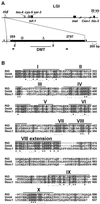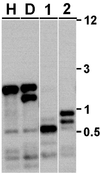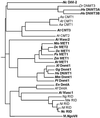A cytosine methyltransferase homologue is essential for repeat-induced point mutation in Neurospora crassa
- PMID: 12072568
- PMCID: PMC124379
- DOI: 10.1073/pnas.132212899
A cytosine methyltransferase homologue is essential for repeat-induced point mutation in Neurospora crassa
Abstract
During sexual development, Neurospora crassa inactivates genes in duplicated DNA segments by a hypermutation process, repeat-induced point mutation (RIP). RIP introduces C:G to T:A transition mutations and creates targets for subsequent DNA methylation in vegetative tissue. The mechanism of RIP and its relationship to DNA methylation are not fully understood. Mutations in DIM-2, a DNA methyltransferase (DMT) responsible for all known cytosine methylation in Neurospora, does not prevent RIP. We used RIP to disrupt a second putative DMT gene in the Neurospora genome and tested mutants for defects in DNA methylation and RIP. No effect on DNA methylation was detected in the tissues that could be assayed, but the mutants showed recessive defects in RIP. Duplications of the am and mtr genes were completely stable in crosses homozygous for the mutated potential DMT gene, which we call rid (RIP defective). The same duplications were inactivated normally in heterozygous crosses. Disruption of the rid gene did not noticeably affect fertility, growth, or development. In contrast, crosses homozygous for a mutation in a related gene in Ascobolus immersus, masc1, reportedly fail to develop and heterozygous crosses reduce methylation induced premeiotically [Malagnac, F., Wendel, B., Goyon, C., Faugeron, G., Zickler, D., et al. (1997) Cell 91, 281-290]. We isolated homologues of rid from Neurospora tetrasperma and Neurospora intermedia to identify conserved regions. Homologues possess all motifs characteristic of eukaryotic DMTs and have large distinctive C- and N-terminal domains.
Figures





Similar articles
-
Genetic transformation of Neurospora tetrasperma, demonstration of repeat-induced point mutation (RIP) in self-crosses and a screen for recessive RIP-defective mutants.Genetics. 2004 Jul;167(3):1155-64. doi: 10.1534/genetics.103.025171. Genetics. 2004. PMID: 15280231 Free PMC article.
-
dim-2 encodes a DNA methyltransferase responsible for all known cytosine methylation in Neurospora.EMBO J. 2001 Aug 1;20(15):4309-23. doi: 10.1093/emboj/20.15.4309. EMBO J. 2001. PMID: 11483533 Free PMC article.
-
Collateral damage: spread of repeat-induced point mutation from a duplicated DNA sequence into an adjoining single-copy gene in Neurospora crassa.J Biosci. 2005 Feb;30(1):15-20. doi: 10.1007/BF02705146. J Biosci. 2005. PMID: 15824437
-
Recombination-independent recognition of DNA homology for repeat-induced point mutation.Curr Genet. 2017 Jun;63(3):389-400. doi: 10.1007/s00294-016-0649-4. Epub 2016 Sep 14. Curr Genet. 2017. PMID: 27628707 Free PMC article. Review.
-
RIP: the evolutionary cost of genome defense.Trends Genet. 2004 Sep;20(9):417-23. doi: 10.1016/j.tig.2004.07.007. Trends Genet. 2004. PMID: 15313550 Review.
Cited by
-
Plant-symbiotic fungi as chemical engineers: multi-genome analysis of the clavicipitaceae reveals dynamics of alkaloid loci.PLoS Genet. 2013;9(2):e1003323. doi: 10.1371/journal.pgen.1003323. Epub 2013 Feb 28. PLoS Genet. 2013. PMID: 23468653 Free PMC article.
-
DNA methylation affects meiotic trans-sensing, not meiotic silencing, in Neurospora.Genetics. 2004 Dec;168(4):1925-35. doi: 10.1534/genetics.104.031526. Genetics. 2004. PMID: 15611165 Free PMC article.
-
Genome sequencing and comparative transcriptomics of the model entomopathogenic fungi Metarhizium anisopliae and M. acridum.PLoS Genet. 2011 Jan 6;7(1):e1001264. doi: 10.1371/journal.pgen.1001264. PLoS Genet. 2011. PMID: 21253567 Free PMC article.
-
Maintenance of sex-related genes and the co-occurrence of both mating types in Verticillium dahliae.PLoS One. 2014 Nov 10;9(11):e112145. doi: 10.1371/journal.pone.0112145. eCollection 2014. PLoS One. 2014. PMID: 25383550 Free PMC article.
-
Comparative genomics reveals high biological diversity and specific adaptations in the industrially and medically important fungal genus Aspergillus.Genome Biol. 2017 Feb 14;18(1):28. doi: 10.1186/s13059-017-1151-0. Genome Biol. 2017. PMID: 28196534 Free PMC article.
References
-
- Cogoni C. Annu Rev Microbiol. 2001;55:381–406. - PubMed
-
- Vaucheret H, Beclin C, Fagard M. J Cell Sci. 2001;114:3083–3091. - PubMed
-
- Fire A, Xu S, Montgomery M K, Kostas S A, Driver S E, Mello C C. Nature (London) 1998;391:806–811. - PubMed
-
- Elbashir S M, Harborth J, Lendeckel W, Yalcin A, Weber K, Tuschl T. Nature (London) 2001;411:494–498. - PubMed
-
- Miao V P, Freitag M, Selker E U. J Mol Biol. 2000;300:249–273. - PubMed
Publication types
MeSH terms
Substances
Associated data
- Actions
- Actions
- Actions
- Actions
- Actions
- Actions
- Actions
- Actions
Grants and funding
LinkOut - more resources
Full Text Sources
Other Literature Sources
Molecular Biology Databases
Miscellaneous

